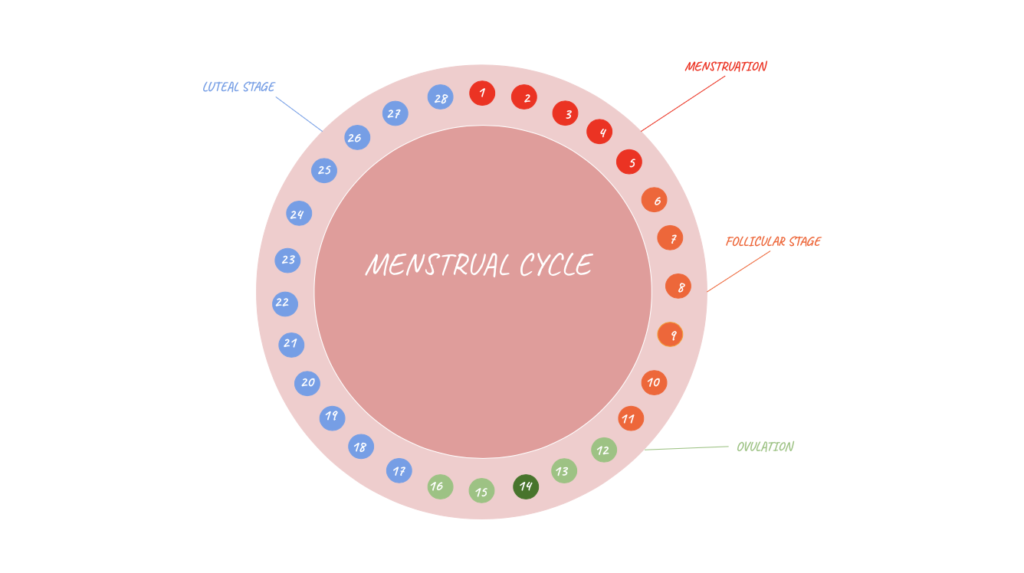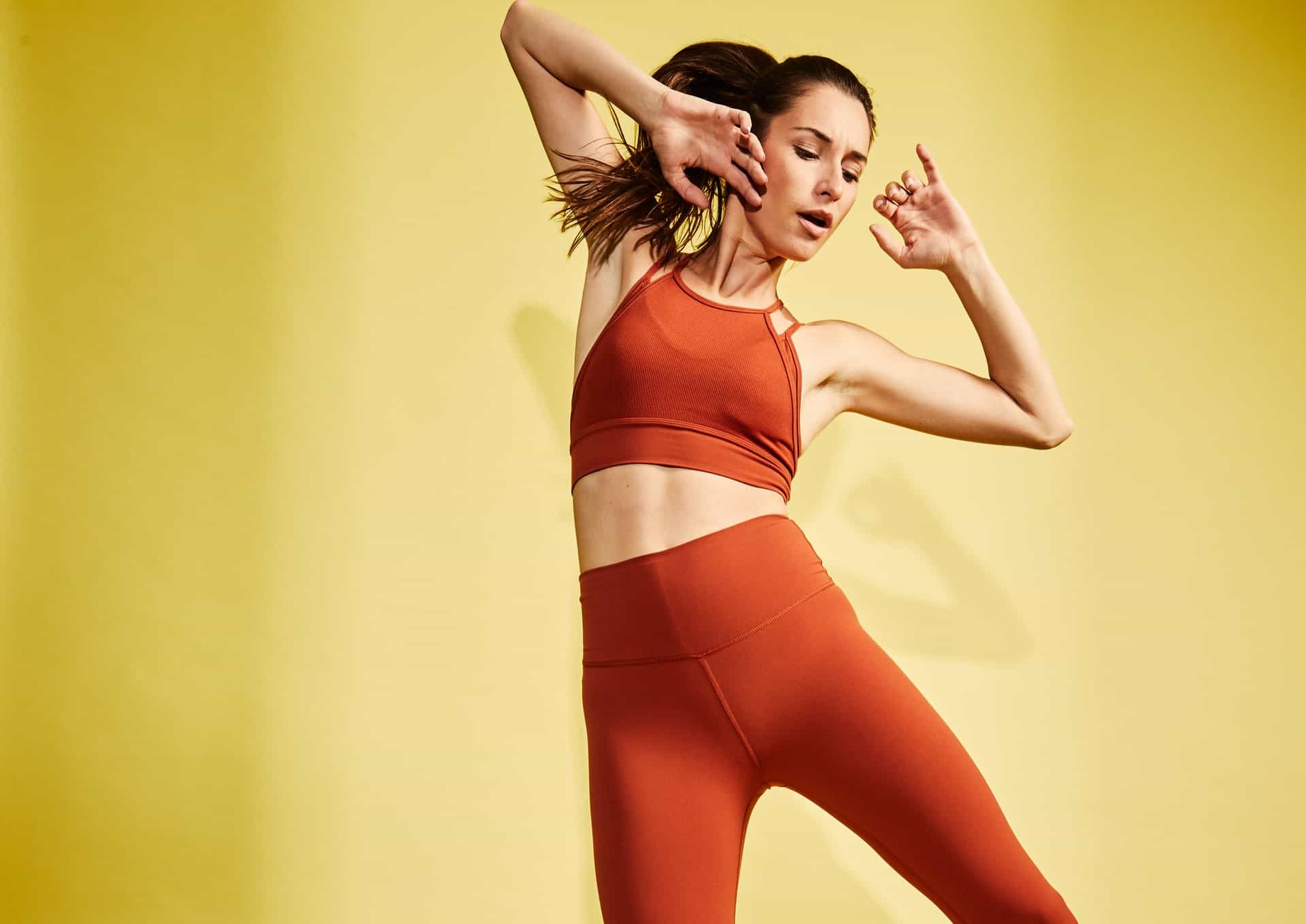Like every woman, you’ve likely had days where your menstrual cycle has impacted your workout routine.
Or, maybe you have questions about how and when you should work out during your period.
While most women focus on the impact that periods have on their exercise routine, the whole menstrual cycle – that is, the hormonal process that takes place over 28-29 days – can influence how your workout and how much.
In fact, study revealed that hormone fluctuations over the menstrual cycle can affect your energy levels, emotional status, appetite, and much more.
However, this can vary from woman to woman with the potential to be impacted by many contraceptive methods.
While there is no medical reason to avoid exercising during any of the phases of your menstrual cycle (including the days when you shed blood), the hormonal changes occurring in your body make it easier or more difficult to perform certain types of exercise.
In this article, we discuss how to approach exercise at each stage of your cycle, including your period.
But first, let’s see what happens exactly in the 28-29 days of your menstrual cycle.
The Four Phases of the Menstrual Cycle

Maybe it goes without saying or maybe not, but your period is just the first phase of your menstrual cycle.
Your menstrual cycle is actually made up of four phases that start with the first day of your period and end with the start of the next period.
Your menstrual cycle includes the following phases:
Menstruation (Days 1-5)
The first day of your period represents day 1 of your menstrual cycle. If you don’t get pregnant, the lining of your uterus begins to shed.
During this phase of your menstrual cycle, levels of oestrogen and progesterone are low.
Like most women, you may experience mild cramping and discomfort during menstruation. Unless you experience severe cramps, exercising during your period can actually help you reduce pain and keep the serotonin flowing in your body.
Follicular Phase (Days 1-13)
The follicular phase refers to the time between the first day of your period and ovulation (meaning there is some overlap with the menstrual phase).
During this phase, the pituitary gland starts to produce FSH (Follicle-Stimulating Hormone), making the follicles – the sacs in your ovaries that contain eggs – grow and producing oestrogen.
Your uterus lining becomes thicker in preparation to receive a fertilised egg.
Ovulation (Day 14)
Ovulation typically occurs 12 to 16 days before the following period. If you have a 28-day cycle, ovulation happens at around day 14.
During this phase, your ovaries release a mature egg that must be fertilised for a pregnancy to happen.
If it isn’t fertilised, the egg will die or dissolve after 24 hours.
Luteal Phase (Days 15-28)
The luteal phase refers to the time between ovulation and the day before your period starts.
During this phase, the follicle from which a mature egg was released becomes a structure known as the yellow body of the ovary or corpus luteum.
The corpus luteum produces a large quantity of progesterone for a 14-day period.
If fertilisation does not occur, the corpus luteum will die and progesterone levels drop, causing the lining of your uterus to shed (the first day of your period or the menstruation phase).
How to Approach Exercise During Every Menstrual Cycle Phase
Now that you have a clear idea of the four phases of your menstrual cycle, let’s discuss how to approach workouts during each of these phases.
Adjusting your exercise routine according to your menstrual cycle is called cycle syncing.
The method was first introduced by Alisa Vitti, functional nutritionist and women’s hormone expert.
Cycle syncing is thought to provide several benefits, such as feeling more balanced and energised and making workouts more effective.
But first, it is important to understand that each body is different.
There are many factors influencing your menstrual cycle and how you feel during PMS and your period, such as:
- Body fat percentage
- Stress level
- Birth control methods
Below I’ll share some tips to help you to maximise your workouts during each phase of your menstrual cycle, but remember each body is unique, so a lot of external factors will determine how your cycle actually flows.
That’s why it is important to listen to your body during each phase of your cycle.
Menstruation
During your period, you tend to feel fatigued, so you may not have the energy for an intense workout.
While exercising when you’re bleeding and cramping may seem counterintuitive, it can actually help you alleviate menstrual symptoms and increase the production of endorphins (“feel-good hormones”).
If you experience heavy bleeding the first few days of your period, you may feel more comfortable exercising at home.
Here are some of the best exercises to do on your period:
- Walking
- Gentle stretching and balancing
- Light cardio (e.g., jogging, cycling, swimming)
- Gentle strength exercises
While you don’t necessarily have to stop your normal training, you should avoid strenuous or prolonged exercise.
Some claim that you should also avoid yoga inversions such as plough pose, headstand, etc.
Although there’s not a lot of science to back up this theory, it is thought that postures that take you upside down are counterintuitive because the natural flow of a woman’s cycle goes downwards.
Follicular phase
As previously mentioned, the follicular phase starts the same day as your period.
However, it continues past the period stage, when your oestrogen and testosterone levels start to rise.
This can make it easier for your body to access stored carbohydrates so you can build muscle.
For this reason, the follicular phase is the perfect time to push yourself a little more with:
- High-Intensity Interval Training (HIIT) – When your energy levels are high, HIIT workouts are the perfect way to exercise so you can lose fat and burn a lot of calories in a short amount of time.
- Strength training – This is the perfect time to challenge yourself with heavier weights. Or, you can try more challenging bodyweight exercises, such as feet-elevated push-ups instead of knee push-ups. Or, if you typically hold a plank for 30 seconds, you can try to hold it for 45 seconds or even one minute.
Ovulation
During the ovulation phase, your oestrogen levels are still high.
This period lines up perfectly with a peak in your energy levels, so you can maximise high training efforts.
Similar to the follicular phase, ovulation is the phase in your menstrual cycle when you need less insulin to keep blood glucose levels in the normal range.
Because your body is more insulin sensitive during the first half of your cycle, carbohydrates are used more efficiently.
This means you can continue to participate in High-Intensity Interval Training and strength training.
Luteal Phase
During the first part of the luteal phase, you still have energy from the ovulation phase.
However, your energy levels will decrease the closer you get to menstruation.
During the second half of your cycle when progesterone (a female sex hormone produced mainly in the ovaries after ovulation) levels are higher, your body becomes more insulin resistant.
This makes it more difficult for your body to take up glucose from blood or store it.
So what does this mean in relation to your workout?
While you can continue with your usual workout routine, aerobic exercises such as swimming, cycling or jumping rope work better during the luteal phase because they do not require fast access to glucose.
You may also fatigue faster and need more time to recover, so you may want to consider gentler movement practices, such as yoga or pilates.
If you feel really drowsy – especially a few days before your period starts – it’s best to focus on light cardio or gentle strength exercises.
The Bottom Line
To know which phase of your cycle you are in and plan your workouts accordingly, it is important that you track your menstrual cycle.
You can do that by keeping a record of when you’re menstruating and documenting any changes in your mood and energy levels.
However, as a general rule, it is more important to adjust the intensity of your workouts according to your menstrual cycle than completely change your workout routine.
For example, you don’t have to only lift weights during the first half of your cycle and do light cardio during the second half of your cycle – not to mention that such an approach wouldn’t be beneficial for weight loss.
If you’re combining cardio and strength training for maximum weight loss results, you should do that throughout your whole menstrual cycle – the only difference should lie in the intensity of your workouts.
This will help you lose weight and gain muscle as you learn how to synchronise your workouts around your menstrual cycle phases and develop greater compassion towards your body.
Sources:
Better Health Channel – Menstrual Cycle
Healthline – Stages of the menstrual cycle
Menstrupedia – Phases of menstrual cycle
National Library of Medicine – Effects of the menstrual cycle on exercise performance
